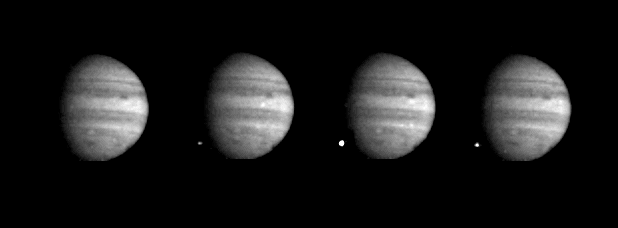
Galileo's Observations

Galileo
Click here to see Galileo's view of Jupiter during one of the impacts.
At present, the Galileo spacecraft is about 150 million miles (240 million
kilometers) from Jupiter and will be able to see part of the planet's
nightside, where comet impacts are predicted to take place. Galileo will be
capable of taking direct imaging of impact events using visible light imaging,
near-infrared mapping spectrometer, extreme ultraviolet, photopolarimeter,
plasma wave and fields and particles instruments. Pictures and infrared
spectral scans must be tape-recorded for slow playback, which is expected in a
month or two. Other data will be computer-stored for readout within several
days. Galileo is managed by the Jet Propulsion Laboratory in Pasadena, Calif.,
for NASA's Office of Space Science.
Public Affairs contact:
James H. Wilson
Jet Propulsion Laboratory
Pasadena,
Calif.,
(818) 354-5011
Galileo Observation Plans
Galileo Observations
- First direct impact observations are reported by the Galileo spacecraft team (July 19, 1994).
- Galileo Mission Status Report (August 1, 1994).
- Galileo Begins Sending Data from SL9 Impacts (August 26, 1994).
- Galileo Mission Status Report (September 1, 1994).
- Status of Galileo SL9 Images (Clark Chapman - September 19,
1994).
- Galileo Mission Status Report (October 1, 1994).
- Galileo PPR Detection of Fragment G Impact.
- Galileo NIMS Observations of Fragment G Impact.
- Galileo UVS Observations of Fragment G Impact (October 13, 1994).
- Additional Galileo PPR Results for Fragment G Impact (October 17, 1994).
- Summary of Comet Day Poster Session (Mark Boslough)
- Galileo Observes Fragment N Impact (October 27, 1994).
- Galileo Comet SL9 Observations (October 31, 1994).
- Galileo Mission Status Report (November 1, 1994).
- Galileo Mission Status Report (December 1, 1994).
- Galileo NIMS Detects Fragment G Fallout on Jupiter.
- The Brilliant Death of Comet SL9 (Galileo Messenger - December 1994).
- Timing is Everything (Galileo Messenger - December 1994).
- Galileo Mission Status Report (January 1, 1995).
- Comet Crash, Asteroid Moon on Galileo's '94 Agenda (January 13, 1995).
- Shoemaker-Levy 9 Observations Widespread (January 13, 1995).
- Galileo Mission Status Report (February 1, 1995).
- Galileo NIMS Detects Fragment R Fireball & Fallout on Jupiter (February 10, 1995).
- Next Jupiter Impact Will Occur in December 1995 (JPL - April 21, 1995).
- A Comet's Fiery Dance at Jupiter (Galileo Messenger - May 1995).
- Galileo Flying Through Intense Dust Storm (August 29, 1995).
- Galileo Mission Status Report (October 1, 1995).
- Galileo Less Three Weeks From Jupiter (JPL - November 17, 1995).
- Galileo Crosses Into Jupiter's Magnetosphere (December 1, 1995).
- Galileo Is In Orbit around Jupiter (JPL - December 7, 1995).
- JPL Celebrates JOI-Ful Milestone (December 15, 1995).
- Galileo Probe Science Results (NASA - January 22, 1996).
Images
Galileo Home Pages
 Comet Shoemaker-Levy Home Page
Comet Shoemaker-Levy Home Page
For suggestions or additions to the this page, please contact:
Ron Baalke
ron@jpl.nasa.gov



![]() Comet Shoemaker-Levy Home Page
Comet Shoemaker-Levy Home Page
